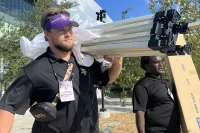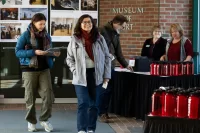
A record number of prospective students have applied for admission to the incoming Bates College Class of 2022.
The 2017–18 recruiting season saw first-year applications from 7,688 prospective students — by far the most ever and a 45 percent increase over last year’s 5,316 first-year applications.
“We are meeting more prospective students where they are and telling a story that is more compelling and relevant than ever,” said Dean of Admission and Financial Aid Leigh Weisenburger.
The previous high-water mark was 5,636 in 2014–15.
“When we tell Bates’ story — about our unwavering commitment to the emancipating potential of the liberal arts, to creative and rigorous scholarship, and to the transformative power of our differences — using traditional admission outreach paired with new-media strategies, the results speak loudly and clearly.”
Among applicants, across-the-board increases in important demographic categories — including geography, first-generation-to-college students, and students of color — “move the overall pool, and thus our incoming class, in the right direction,” she added.
The record level of interest in Bates comes as the college launches The Bates Campaign, which seeks to raise $300 million in the coming years with a strong focus on endowment for academics and financial aid.
In addition, Bates continues to expand its innovative Purposeful Work program and lay the groundwork for a new and fundamentally inclusive Digital and Computational Studies Program.
The 2017–18 recruitment season saw an increase in travel, both nationally and internationally, for the Bates Admission team, including new joint travel with fellow colleges of the American Talent Initiative, of which Bates is a founding member. Supported by Bloomberg Philanthropies and with a target date of 2025, ATI seeks to expand by 50,000 the number of low- and moderate-income students attending 270 top U.S. schools.
In the digital realm, Bates’ expanded suite of web, social media, and email communications and strategies now features a new virtual-visit platform that expands prospective students’ access to one of the most important ways to get to know Bates: the campus tour.
The immersive virtual experience is particularly helpful for students who might find it difficult to visit in person. It also helps to educate potential applicants while guiding them toward various “micro-conversions” that are important in the recruitment process, such as watching a Bates video, clicking a link to an academic department, or scheduling a visit.
Bates has simplified the application process in another way. Effective this year, the college has eliminated the application requirement of a supplemental essay.
“We have found that the essay is an unnecessary barrier in the path of a talented student who deserves access to an excellent education,” said Weisenburger. “Just as Bates was the first to show that standardized testing can narrow the door of college opportunity for talented students, we have made this move to reflect our leadership in creating greater access to higher education.”
A deeper look at the 2018 applicant pool and a comparison to the average applicant pool over the prior five years shows a 56 percent increase in applications from first-generation-to-college students; 40 percent from African American students; 27 percent from Asian American students; and 68 percent from Latino students.
Bates also expanded its U.S. geographic reach in 2018, with more applicants from the West (30 percent over the five-year average), Midwest (49 percent), South (53 percent), and West (30 percent), as well as New England (14 percent).
International applicants increased by 105 percent, driven by triple-digit increases from China, Pakistan, India, and Ghana.
The incoming class will be finalized this spring. Bates notifies applicants of admission decisions on April 1, and the deadline for accepted students to notify Bates of their intention to enroll is May 1.





